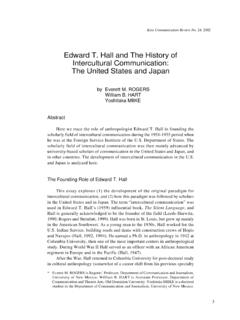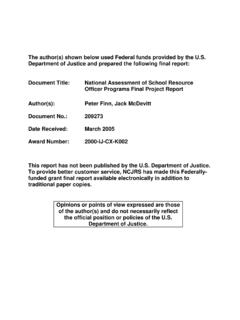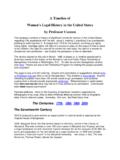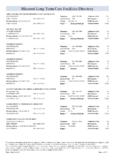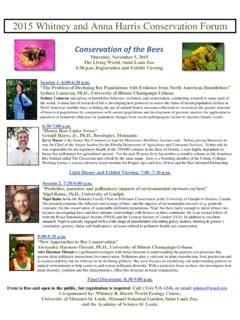Transcription of Edward T. Hall and The History of Intercultural ...
1 Keio Communication Review No. 24, 2002. Edward T. hall and The History of Intercultural Communication: The United States and Japan by Everett M. ROGERS. William B. HART. Yoshitaka MIIKE. Abstract Here we trace the role of anthropologist Edward T. hall in founding the scholarly field of Intercultural communication during the 1951-1955 period when he was at the Foreign Service Institute of the Department of States. The scholarly field of Intercultural communication was then mainly advanced by university -based scholars of communication in the United States and Japan, and in other countries. The development of Intercultural communication in the and Japan is analyzed here. The Founding Role of Edward T. hall This essay explores (1) the development of the original paradigm for Intercultural communication, and (2) how this paradigm was followed by scholars in the United States and in Japan.
2 The term Intercultural communication was used in Edward T. hall 's (1959) influential book, The Silent Language, and hall is generally acknowledged to be the founder of the field (Leeds-Hurwitz, 1990; Rogers and Steinfatt, 1999). hall was born in St. louis , but grew up mainly in the American Southwest. As a young man in the 1930s, hall worked for the Indian Service, building roads and dams with construction crews of Hopis and Navajos ( hall , 1992, 1994). He earned a in anthropology in 1942 at Columbia university , then one of the most important centers in anthropological study. During World War II hall served as an officer with an African American regiment in Europe and in the Pacific ( hall , 1947). After the War, hall returned to Columbia university for post-doctoral study in cultural anthropology (somewhat of a career shift from his previous specialty * Everett M.)
3 ROGERS is Regents' Professor, Department of Communication and Journalism, university of New Mexico. William B. HART is Assistant Professor, Department of Communication and Theatre Arts, Old Dominion university . Yoshitaka MIIKE is a doctoral student in the Department of Communication and Journalism, university of New Mexico. 3. in archaeology), where he participated in a seminar with Abram Kardiner, Clyde Kluckhohn, Ruth Benedict, and others on the relationship of psychiatry and anthropology ( hall , 1992). hall investigated the government's post-World War II administration of the Pacific island of Truk ( hall , 1950). Then, while teaching at the university of Denver, hall conducted a race relations study in Denver for the mayor's office ( hall , 1992). After teaching at Bennington College in Vermont, with Erich Fromm, a Freudian psychoanalyst, hall joined the Foreign Service Institute as a professor of anthropology in 1951.
4 Table 1 details the major events in Edward hall 's life and career. Table 1 Major Events in the Life and Career of Edward T. hall . Date Events 1914 Born in Webster Groves, missouri , a suburb of St. louis 1918-32 Grew up in New Mexico 1933-37 Worked on the Navajo and Hopi reservations in the Southwest 1936 Earned in Anthropology from the university of Denver 1938 Earned in Anthropology from the university of Arizona 1942 Earned in Anthropology from Columbia university 1942-45 Served in WWII, commanding an African American regiment in Europe and the Philippines 1946 Post-doctoral study in Sociology/Cultural Anthropology at Columbia university ;. conducted research on the military government administration of Truk 1946-48 Chairman, Department of Anthropology, university of Denver; studied race relations in Denver 1948-50 Taught at Bennington College in Vermont, with Erich Fromm 1950-55 Director of the Point IV Training Program at the Foreign Service Institute, Washington, 1952-56 Affiliated with the Washington School of Psychiatry, Washington, 1955 Publication of "The Anthropology of Manners" in the Scientific American 1959 Publication of The Silent Language 1960-63 Affiliated (again) with the Washington School of Psychiatry 1963-67 Professor of Anthropology, Illinois Institute of Technology, Chicago.
5 Conducted NIMH- funded research on proxemics and interethnic encounters 1966 Publication of The Hidden Dimension 1967-77 Professor of Anthropology, Northwestern university , until his retirement in 1977;. conducted further NIMH funded research on proxemics and interethnic encounters 1976 Participated in the Conference on Intercultural Communication, International Christian university , Tokyo 1976 Publication of Beyond Culture 1977 Presented a paper at the International Communication Association Conference, Berlin ( hall , 1978). 1977-Present Living in retirement in Santa Fe, New Mexico; Occasional lectures at SIETAR. conferences and the Summer Institute of Intercultural Communication; teaching at the university of New Mexico (1997 and 1999). Source: hall (1992, 1994), hall 's 1979 Curriculum Vitae in Box 6, Folder 5 of the hall Papers, Special Collections, university of Arizona Library.
6 4. Keio Communication Review No. 24, 2002. Scholarly Influences on hall The original paradigm for Intercultural communication took form in conceptualizations by hall and others at the Foreign Service Institute in the early 1950s. What were the major intellectual influences on this conceptualization? hall 's early life experiences as he grew up in the culturally diverse state of New Mexico, and commanded an African American regiment in World War II, were important influences. hall says that from his work with the Hopi and Navajo he learned firsthand about the details and complexities of one of the world's most significant problems: Intercultural relations ( hall , 1992, ). hall 's personal experiences brought the problems of Intercultural communication to his attention, but scholarly influences brought hall to the investigation of Intercultural communication.
7 hall 's graduate training in anthropology at Columbia university and his work as an applied anthropologist in the Foreign Service Institute brought him in contact with scholars who influenced his conceptualization of Intercultural communication. hall identified four major influences on his work: (1) cultural anthropology, (2) linguistics, (3). ethology, the study of animal behavior, and (4) Freudian psychoanalytic theory ( hall , 1992; Sorrells, 1998). 1. Cultural Anthropology: Cultural anthropology served as both a positive and negative influence on hall 's formation of the paradigm for Intercultural communication. At Columbia university hall was particularly influenced by Franz Boas and Ruth Benedict (Hart, 1996b). In The Hidden Dimension, hall acknowledged that the connection that he made between culture and communication in his noted book The Silent Language had its beginnings with Boas who laid the foundation of the communication constitutes the core of ( hall , 1966, ).
8 The strong emphasis on cultural relativism by Boas and Benedict is evident in hall 's work. Margaret Mead, who preceded hall in helping the government apply anthropological understandings, and Raymond L. Birdwhistell, who was trained in cultural anthropology and who pioneered the study of kinesics, also influenced hall . hall did not accept certain important aspects of an anthropological perspective, however. Anthropologists generally focus on macro-level, single- culture studies, investigating the economic, government, kinship, and religious systems of a single culture. hall 's approach at FSI focused on the micro-level behaviors of interactions between people of different cultures. This Intercultural approach grew out of his applied work at FSI, where he taught a workshop course, Understanding Foreign People, to American diplomats (Murray, 1994).
9 2. Linguistics: At the FSI, hall 's most influential colleague was George L. Trager, a linguist with post-doctoral training at Yale university with Edward Sapir and Benjamin Lee Whorf from 1936 to 1941 (Carroll, 1940/1956; Hockett, 1993). Trager was perhaps closer to Whorf than any other scholar of his day;. 5. they shared scholarly interests in Native American languages of the American Southwest, Hopi for Whorf and Tanoan for Trager (Hockett, 1993). Thus hall was exposed to the concept of linguistic relativity, the process through which language influences human thought and meaning (Whorf, 1940/1956). hall later said that what Whorf did for understanding the influence of language on human thinking, hall himself did for human behavior through his study of nonverbal communication (Leeds-Hurwitz, 1990).
10 3. Ethology: hall developed an interest in biology during his teenage years ( hall , 1992). This interest, particularly in animal behavior, is evidenced in his books The Hidden Dimension (concerning animal crowding and the handling of space) and Beyond Culture (regarding action chains). The map of culture in The Silent Language is rooted in biology. hall 's classification of time (and culture) as formal, informal, and technical was based on Paul MacLean's reptilian, limbic, and neo-cortex (triune) brain theory (Sorrells, 1998). 4. Freudian psychoanalytic theory: The unconscious level of communication was a strong influence on hall and his colleagues at the Foreign Service Institute, especially their conception of nonverbal communication. We previously mentioned (1) hall 's participation in the post-doctoral seminar on culture and personality, based on cultural anthropology and psychoanalytic theory, at Columbia university in 1946 ( hall , 1992), and (2) his intellectual friendship with Erich Fromm at Bennington College.
